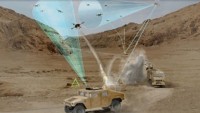DARPA Developing Next Gen US Electronic Warfare Systems Masterminded by AI
| Arthur Dominic Villasanta | | Aug 30, 2016 09:20 PM EDT |
(Photo : US Navy) US Navy EA-18G Growler with jammers and missiles
The U.S. Defense Advanced Research Projects Agency (DARPA) is developing "cognitive electronic warfare (EW) systems" to learn how to jam enemy systems using never-before-seen frequencies and waveforms such as those generated by digitally programmable radars.
These new waveforms are harder to defeat using current EW technologies. A Defense Science Board study in 2013 recommended the Pentagon develop agile and adaptive electronic warfare systems that can detect and counter digitally programmable radars.
Like Us on Facebook
This new subset of EW called "cognitive electronic warfare" is still in its early stages of development but devices that can make it happen might appear on the battlefield by the 2020s.
DARPA began pioneering cognitive EW in 2010. It has two flagship programs to advance research into this field: Behavioral Learning for Adaptive Electronic Warfare or BLADE seeks to use the technology to jam communication systems. The other program, Adaptive Radar Countermeasures, is targeted at defeating radar. Both programs lean heavily on using artificial intelligence (AI) to attain their goals.
The U.S. military's current approach to EW is to study enemy systems for vulnerabilities; figure out ways of disrupting them and then building a playbook filled with different EW tactics, said Yiftach Eisenberg, deputy director of DARPA's microsystems technology office.
"That approach has worked well for us in the past when the adversaries systems were relatively stable," in other words, when it took enemies years to develop analog sensors and communication systems," he said.
In recent years, however, there's been a fundamental shift to systems that are digital and reprogrammable in nature, and can thus adopt different frequencies, signal characteristics and waveforms to avoid being jammed.
"We need to have the ability to respond to new threats, new waveforms that those systems are using that we haven't anticipated," said Eisenberg.
"If things are changing quickly, then we need systems that can respond in similar timeframes to enable us to protect our aircraft."
Eisenberg said all cognitive EW systems share the same process: characterizing a threat, using machine-learning algorithms to exploit an adversary's vulnerability and ensuring the countermeasure worked.
TagsDefense Advanced Research Projects Agency, DARPA, adaptive electronic warfare, Behavioral Learning for Adaptive Electronic Warfare, Adaptive Radar Countermeasures, Artificial Intelligence, AI, cognitive electronic warfare
©2015 Chinatopix All rights reserved. Do not reproduce without permission
EDITOR'S PICKS
-

Did the Trump administration just announce plans for a trade war with ‘hostile’ China and Russia?
-

US Senate passes Taiwan travel bill slammed by China
-

As Yan Sihong’s family grieves, here are other Chinese students who went missing abroad. Some have never been found
-

Beijing blasts Western critics who ‘smear China’ with the term sharp power
-

China Envoy Seeks to Defuse Tensions With U.S. as a Trade War Brews
-

Singapore's Deputy PM Provides Bitcoin Vote of Confidence Amid China's Blanket Bans
-

China warns investors over risks in overseas virtual currency trading
-

Chinese government most trustworthy: survey
-

Kashima Antlers On Course For Back-To-Back Titles
MOST POPULAR
LATEST NEWS
Zhou Yongkang: China's Former Security Chief Sentenced to Life in Prison

China's former Chief of the Ministry of Public Security, Zhou Yongkang, has been given a life sentence after he was found guilty of abusing his office, bribery and deliberately ... Full Article
TRENDING STORY

China Pork Prices Expected to Stabilize As The Supplies Recover

Elephone P9000 Smartphone is now on Sale on Amazon India

There's a Big Chance Cliffhangers Won't Still Be Resolved When Grey's Anatomy Season 13 Returns

Supreme Court Ruled on Samsung vs Apple Dispute for Patent Infringement

Microsoft Surface Pro 5 Rumors and Release Date: What is the Latest?














